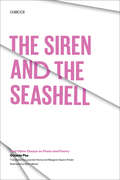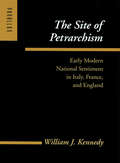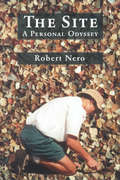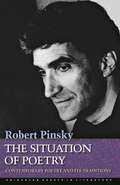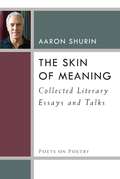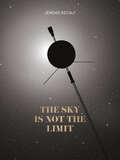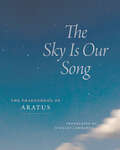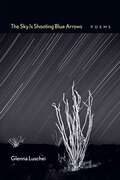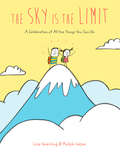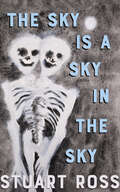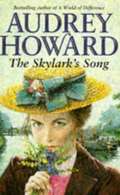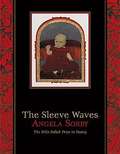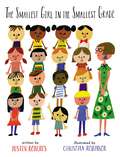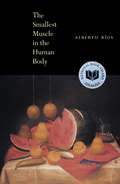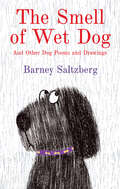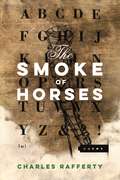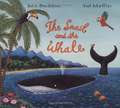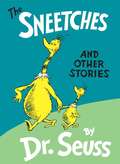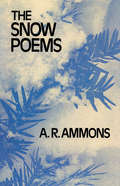- Table View
- List View
The Siren and the Seashell: And Other Essays on Poets and Poetry (Texas Pan American Series)
by Octavio PazOctavio Paz has long been known for his brilliant essays as well as for his poetry. Through the essays, he has sought to confront the tensions inherent in the conflict between art and society and to achieve a unity of their polarities. The Siren and the Seashell is a collection of Paz's essays, focusing on individual poets and on poetry in general. The first five poets he treats are Latin American: Sor Juana Inés de la Cruz, Rubén Darío, José Juan Tablada, Ramón López Velarde, and Alfonso Reyes. Then there are essays on Robert Frost, e. e. cummings, Saint-John Perse, Antonio Machado, and Jorge Guillén. Finally, there are Paz's reflections on the poetry of solitude and communion and the literature of Latin America. Each essay is more than Paz's impressions of one person or issue; each is the occasion for a wider discussion of cultural, historical, psychological, and philosophical themes. The essays were selected from Paz's writing between 1942 and 1965 and provide an overview of the development of his thinking and an exploration of the ideas central in his works.
The Site of Petrarchism: Early Modern National Sentiment in Italy, France, and England (Parallax: Re-visions of Culture and Society)
by William J. KennedyDrawing upon poststructuralist theories of nationalism and national identity developed by such writers as Etienne Balibar, Emmanuel Levinas, Julia Kristeva, Antonio Negri, and Slavoj Zizek, noted Renaissance scholar William J. Kennedy argues that the Petrarchan sonnet serves as a site for early modern expressions of national sentiment in Italy, France, England, Spain, and Germany. Kennedy pursues this argument through historical research into Renaissance commentaries on Petrarch's poetry and critical studies of such poets as Lorenzo de' Medici, Joachim du Bellay and the Pléiade brigade, Philip and Mary Sidney, and Mary Wroth.Kennedy begins with a survey of Petrarch's poetry and its citation in Italy, explaining how major commentators tried to present Petrarch as a spokesperson for competing versions of national identity. He then shows how Petrarch's model helped define social class, political power, and national identity in mid-sixteenth-century France, particularly in the nationalistic sonnet cycles of Joachim Du Bellay. Finally, Kennedy discusses how Philip Sidney and his sister Mary and niece Mary Wroth reworked Petrarch's model to secure their family's involvement in forging a national policy under Elizabeth I and James I.Treating the subject of early modern national expression from a broad comparative perspective, The Site of Petrarchism will be of interest to scholars of late medieval and early modern literature in Europe, historians of culture, and critical theorists.
The Site: A Personal Odyssey
by Robert W. NeroPoetry or potsherds? That’s the surprising dilemma one of Canada’s well-known nature writers confronts in The Site: A Personal Odyssey, a highly personalized account of a lifetime’s involvement as an avocational archaeologist. With deft descriptive powers, Robert Nero leads us gently into this new facet of his amazing spectrum of interests. Not unexpectedly, there even is poetry in his approach to studying prehistoric remains! From childhood through adolescence, to wartime service with the U.S. Army in the Southwest Pacific, from exploring the vast sand dunes of Lake Athabasca to excavating a 3,000-year-old site he discovered west of Winnipeg, Nero allows us to share his enthusiasm and excitement in outdoor adventures. There is always a wonderful immediacy in his narrative, the mark of a gifted writer, whether expressed in prose or poetry.
The Situation of Poetry: Contemporary Poetry and Its Traditions (Princeton Essays in Literature #3)
by Robert PinskyIn this book Robert Pinsky writes about contemporary poetry as it reflects its modernist and Romantic past. He isolates certain persistent ideas about poetry's situation relative to life and focuses on the conflict the poet faces between the nature of words and poetic forms on one side, and the nature of experience on the other. <P><P>The author ranges for his often surprising examples from Keats to the great modernists such as Stevens and Williams, to the contents of recent magazines. He considers work by Ammons, Ashbery, Bogan, Ginsberg, Lowell, Merwin, O'Hara, and younger writers, offering judgments and enthusiasms from a viewpoint that is consistent but unstereotyped. Like his poetry, Robert Pinsky's criticism joins the traditional and the innovative in ways that are thoughtful and unmistakably his own. His book is a bold essay on the contemporary situation in poetry, on the dazzling achievements of modernism, and on the nature or "situation" of poetry itself.
The Skin You Live In
by Michael Tyler David Lee CsicskoWith the ease and simplicity of a nursery rhyme, this lively story delivers an important message of social acceptance to young readers. Themes associated with child development and social harmony, such as friendship, acceptance, self-esteem, and diversity are promoted in simple and straightforward prose. Vivid illustrations of children's activities for all cultures, such as swimming in the ocean, hugging, catching butterflies, and eating birthday cake are also provided. This delightful picturebook offers a wonderful venue through which parents and teachers can discuss important social concepts with their children.
The Skin of Meaning: Collected Literary Essays and Talks
by Aaron ShurinIn The Skin of Meaning, Aaron Shurin has collected thirty years' worth of his provocative essays. Fueled by gender and queer studies and combined with radical traditions in poetry, Shurin's essays combine a highly personal and lyrical vision with a trenchant social analysis of poetry's possibilities. Whether he's examining innovations in poetic form, analyzing the gestures of drag queens, or dissecting the language of AIDS, Shurin's writing is evocative, his investigations rigorous, and his point of view unabashed. Shurin's poetic practice braids together many strands in contemporary, innovative writing, from the San Francisco Renaissance to Language Poetry and New Narrative Writing. His mentor-ships with Robert Duncan and Denise Levertov; his studies at New College of California, where he was the first graduate of the epochal Poetics Program; and his years of teaching writing provide a rich background for these essays. San Francisco provides the color and context for formulations of "prosody now," propositions of textual collage, and theories of radical narrativity, while the heart of the book searches through the dire years of the AIDS epidemic to uncover poetic meaning, and "make the heroes heroes. " Book jacket.
The Sky Is Not the Limit
by Jérémie DecalfA poetic odyssey through space with the groundbreaking Voyager 2 probe—past Earth, into deep space and beyond.In 1977, a space probe was built to help human beings learn a little more about outer space. Soon, along with its twin, Voyager 2 slipped through the clouds and left Earth behind. The spacecraft traveled for years through the deep, infinite night. At last Voyager 2 reached its first goal: Jupiter. Then it met the spellbinding sight of Saturn. Then, going further than any previous mission, the probe visited the blue ice giants Uranus and Neptune. Past the boundaries of our solar system, Voyager 2 sails on, carrying a Golden Record for any new friends it makes in interstellar space…This lyrical, atmospheric book introduces young readers to a pioneering NASA spacecraft that has spent over forty-five years observing and exploring our galaxy. With stirring poetry, luminous art, and fascinating back matter, The Sky Is Not the Limit will inspire future scientific innovators and foster a sense of wonder at our universe.
The Sky Is Our Song: The "Phaenomena" of Aratus
by AratusAn ancient Greek guide to the heavens, translated in a new accessible modern English edition. A poetic guide to the heavens, the Phaenomena of Aratus—dating from around 270 BCE—was widely known across the ancient world, second only in fame to the works of Homer. Beginning with an invocation to Zeus, the poem describes the constellations of the northern and southern skies, the celestial sphere, and weather signs. Aratus’s vivid work offered a complete handbook of astronomy, constellations, and weather, and this treatise on the night sky was later translated or adapted by luminaries including Cicero, Virgil, and Ovid. The Phaenomena remained popular throughout the Renaissance and had more than sixty printed editions by the early seventeenth century, but its fame has faded in the modern world. With this edition, renowned translator and amateur astronomer Stanley Lombardo renders Aratus’s poem in reader-friendly vernacular English verse. Complete with endnotes, an accessible introduction, and astronomically accurate illustrations, The Sky Is Our Song brings this master poet’s celebration of the sky to a twenty-first-century audience, inviting new readers to follow Aratus on a visual journey through star signs, moon phases, weather phenomena, and all wonders of the heavens.
The Sky Is Shooting Blue Arrows: Poems (Mary Burritt Christiansen Poetry Series)
by Glenna LuscheiIn this new book Glenna Luschei&’s poems take her and her readers around the world, including to Tunisia and Colombia, but in the end they return to center on the American West, where her heart lies. Celebrating life, travel, aging, and nature, this new book shines with Luschei&’s view of the world.
The Sky Is the Limit: A Celebration of All the Things You Can Do
by Ralph Lazar Lisa SwerlingFrom the bestselling creators of Happiness Is comes a celebration of the many delightful, triumphant, silly, sweet, life-changing experiences that lie ahead.A world full of wonder is waiting for you . . . the sky is the limit of what you can do!The only thing needed to begin this marvelous adventure? YOU! From far-reaching endeavors to the quieter milestones that have a magic all of their own, this book celebrates life's most meaningful moments, and encourages readers to reach for a sky's worth of possibilities.• A joyous all-ages book perfect for families and children celebrating everyday accomplishments• An inspiring graduation read• Lisa Swerling and Ralph Lazar are the creators of the critically acclaimed and bestselling Happiness Is... series.In the spirit of Yay, You!, I Knew You Could, and Oh the Places You'll Go, The Sky Is the Limit will hold a cherished place in the hearts of readers young and old.• Read-aloud toddler booksLisa Swerling and Ralph Lazar are famed illustrators, the authors of the New York Times bestseller Me Without You, and the creators of the internationally beloved Happiness Is . . . brand. They live in Marin County, California.
The Sky Watched: Poems of Ojibwe Lives
by Linda LeGarde GroverA collective memoir in poetry of an Ojibwe family and tribal community, from creation myth to this day, updated with new poems Reaching from the moment of creation to the cry of a newborn, The Sky Watched gives poetic voice to Ojibwe family life. In English and Ojibwe, those assembled here—voices of history, of memory and experience, of children and elders, Indian boarding school students, tribal storytellers, and the Manidoog, the unseen beings who surround our lives—come together to create a collective memoir in poetry as expansive and particular as the starry sky.This world unfolds in the manner of traditional Ojibwe storytelling, shaped by the seasons and the stages of life, marking the significance of the number four in the Ojibwe worldview. Summoning spiritual and natural lore, award-winning poet and scholar Linda LeGarde Grover follows the story of a family, a tribe, and a people through historical ruptures and through intimate troubles and joys—from the sundering of Ojibwe people from their land and culture to singular horrors like the massacre at Wounded Knee to personal trauma suffered at Indian boarding schools. Threaded throughout are the tribal traditions and knowledge that sustain a family and a people through hardship and turmoil, passed from generation to generation, coming together in the manifold power and beauty of the poet&’s voice.
The Sky is a Sky in the Sky
by Stuart RossThe sky’s the limit in these funny and sad head-in-the-clouds poems.The Sky Is a Sky in the Sky is a laboratory of poetic approaches and experiments. It mines the personal and imaginary lives of Stuart Ross and portraits of his grief and internal torment, while paying homage to many of the poet’s literary heroes. It contains new entries in Ross’s ongoing Razovsky poems, prose poems, a remix of an entire poetry book by dear friend Nelson Ball, a couple of collaborative poems, some one-line poems, and lots more. In an era of thematic poetry and conceptual poetry books, this collection is a celebration of possibilities and miscellany."Stuart Ross doesn’t hold back, happily for us. In letting his poems go where they want to go, sometimes by leaps and bounds, he reminds us that poetic rules are meant to be broken and that the results, in the hands of a skillful poet, can be moving, or amusing, or subversive, or exhilarating, or all of the above. His work brims with surprises. From start to finish, The Sky Is a Sky in the Sky is a delightful and thoroughly engaging book." – Charles North, author of News, Poetry and Poplars: Poems/Selected Prose"Here, we’re invited to gawk at horror and kick it in the pants, but also to notice the horror within us, because we all have it, and Ross doesn’t shy away from the odd and uncomfortable. He’s easy with sentiment, honest about grief, clear about death being our final destination, and behooves us mightily to enjoy it while we can. This book contains some of Ross’s greatest love songs for the dead as well as some sideways laments for the living – in these poems we can see ourselves and our friendships, our future losses, and present mysteries examined with no preference or perfunctory reverence. Each time I read Stuart Ross’s work I feel grateful, hopeful, reminded to lift my skeleton up and enjoy the abundant wonders the world holds." – Gillian Wigmore, author of Orient"Stuart Ross is one of the most important poets to have found himself somehow on planet Earth, where readers have been rejoicing in his work for nearly six decades. He makes it seem easy: open your eyes, your ears, your heart; look into the world and write. However, to do so with such unflinching candour, many-layered humour, the deepest emotional intelligence, and rarest lyric acumen? No, you have to be Stuart Ross to bring all of everything to bear upon being alive in one’s time. To rejoice is also to mourn, of course, and these poems are afraid to do neither. Ross trusts poetry more than any of us, so poetry trusts him back: this book dazzles the very sunlight with what it knows, including of the estrangements of the self upon which poetry so often insists, and the fictitiousness of borders between the present and the past, dream and not-dream, hilarity and grief. Whoever you are, including the laws of physics, you will be startled and moved by The Sky Is a Sky in the Sky. At times a momentarily posthumous point of view propels the poems, but do not grieve (or do): the book is immortal." – Lisa Fishman, author of Mad World, Mad Kings, Mad Composition
The Skylark's Song
by Audrey HowardZoe Taylor is born into poverty and hardship. But her beauty marks her out as someone special, and when local schoolmistress Joanna Dale adopts her, Zoe is given her chance for a new life far removed from the violence and squalor of her past. But fate conspires against her, and she is forced back to her old home where her father's violence threatens her yet again. Her only escape is to run away to the wild and rolling moors, and it is there she meets the only man she will ever love, a man forever out of reach ... .
The Sleep That Changed Everything (Wesleyan Poetry Series)
by Lee Ann BrownOffering both subtle and immediate pleasures, Lee Ann Brown's generous new book extends her unmistakable, original voice, every bit as Southern as it is avant-garde, gracious without being naive. Abounding in a playfulness of style, including songs and ballads, the poems in The Sleep That Changed Everything are by turns funny, serious, insightful and moving. Botanical and scientific language are used here as collage elements to chart cycles of desire and emotional transformation. Brown is committed to Whitman's idea that we all have many selves; thus her work embraces the immediacy of the New York School, the personal and literary wildness of the Beats, the word play and political astuteness of Language poetry and an eroticism all her own. In poems that are both highly literate and plain-spoken, Brown makes the life of the soul directly available in all its renegade garb.
The Sleeve Waves
by Angela SorbyWinner of the 2014 Felix Pollak Prize in Poetry, selected by Naomi Shihab Nye Inspired by thrift store knit sleeves, punk rock record sleeves, and, of course, print book sleeves, Angela Sorby explores how the concrete world hails us in waves of color and sound. She asks implicitly, #147;What makes the sleeve wave? Is it the body or some force larger than the self?” As Sorby’s tough, ironic, and subtly political voice repeatedly insists, we apprehend, use, and release more energy than we can possibly control. This collection includes two main parts#151;one visual, one aural#151;flanking a central pastoral poem sung by Virgilian sheep. Meant to be read both silently and aloud, the poems in The Sleeve Waves meditate on how almost everything#151;like light and sound#151;comes to us in waves that break and vanish and yet continue.
The Small Nouns Crying Faith
by Phil HallThe first word in this new collection by Phil Hall is "raw" and the last word is "blurtip." Between these, many nouns cry faith within a hook-less framework that sings in chorus while undermining such standard forms & tropes as "the memoir," "genealogy" and "the shepherd's calendar." With a rural pen, these poems talk frogs, carrots, local noises, partial words, remnants, dirt roads, deep breath & hope: my laboratory the moment is accordion-shaped - cluttered - sopping & not eternal
The Smallest Girl In The Smallest Grade
by Justin RobertsThe young Sally McCabe was the smallest girl in the smallest grade, she notices everything—from the twenty-seven keys on the janitor’s ring to the bullying happening on the playground. One day, Sally decides to make herself heard, and she takes a chance and stands up to the bullies, she finds that one small girl can make a big difference.
The Smallest Girl in the Smallest Grade
by Justin RobertsHardly anyone noticed young Sally McCabe.She was the smallest girl in the smallest grade. But Sally notices everything—from the twenty-seven keys on the janitor’s ring to the bullying happening on the playground. One day, Sally has had enough and decides to make herself heard. And when she takes a chance and stands up to the bullies, she finds that one small girl can make a big difference.Grammy-nominated children’s musician Justin Roberts, together with vibrant artwork from award-winning illustrator Christian Robinson, will have readers cheering for young Sally McCabe.
The Smallest Muscle in the Human Body
by Alberto RíosAlberto Ríos explains the world not through reason but magic. These poems--set in a town that straddles Mexico and Arizona--are lyric adventures, crossing two and three boundaries as easily as one, between cultures, between languages, between senses. Drawing upon fable, parable, and family legend, Ríos utilizes the intense and supple imagination of childhood to find and preserve history beyond facts: plastic lemons turning into baseballs, a grandmother's long hair reaching up to save her life, the painted faith jumpers leaping to the earth and crowd below. This is magical realism at its shimmering best. The smallest muscle in the human body is in the ear. It is also the only muscle that does not have blood vessels; It has fluid instead. The reason for this is clear: The ear is so sensitive that the body, if it heard its own pulse, Would be devastated by the amplification of its own sound. In this knowledge I sense a great metaphor, But I do not want to be hasty in trying to capture or describe it. Words are our weakest hold on the world. -from "Some Extensions of the Sovereignty of Science" "Ríos is onto something new in his poetry, in the way that the real poets of any time always are." -American Book Review. Alberto Ríos teaches at Arizona State and is the author of eight books of poetry, three collections of short stories, and a memoir about growing up on the Mexican border. He is the recipient of numerous awards and his work is included in over 175 national and international literary anthologies. His work is regularly taught and translated, and has been adapted to dance and both classical and popular music.
The Smallest Muscle in the Human Body
by Alberto RíosNational Book Award finalistAlberto Ríos explains the world not through reason but magic. These poems-set in a town that straddles Mexico and Arizona-are lyric adventures, crossing two and three boundaries as easily as one, between cultures, between languages, between senses. Drawing upon fable, parable, and family legend, Ríos utilizes the intense and supple imagination of childhood to find and preserve history beyond facts: plastic lemons turning into baseballs, a grandmother's long hair reaching up to save her life, the painted faith jumpers leaping to the earth and crowd below. This is magical realism at its shimmering best."Alberto Ríos is a poet of reverie and magical perception, and of the threshold between this world and the world just beyond. With humor, compassion, and intelligence, Ríos's poems overlay a child's observation and imagination onto our society of daily inequity, poverty, and violence. The light of memory shines on culture, language, family, neighbors, and friends saving them all in stories that become legends, a light so sensual and full it is 'swallowed into the mouth of the eye, / into the throat of the people.'"-National Book Award Judges' comments"Alberto Ríos is a poet of reverie... Whether talking about the smell of food, the essence of a crow or a bear's character or of hard-won human wisdom, Ríos writes in a serenely clear manner that enhances the drama in the quick scenes he summons up."-The New York Times Book Review"... Rios's verse inhabits a country of his own making, sometimes political, often personal, with the familiarity and pungency of an Arizona chili."-The Christian Science Monitor"Alberto Ríos is the man you want to sit next to when it is time to hear a story."-Southwest BookViews"In The Smallest Muscle in the Human Body, Alberto Ríos doesn't borrow a myth. Rather, he finds the myth underlying his own life-myth that translates effectively because it is not confined by language. The images of Ríos' life are so vivid, it is as if he has written a picture book that anyone can understand."-The Home & News Tribune"In his new book of poems, Alberto Ríos has given us evidence and motive for celebration. Ríos' poems follow a path of wonder and gently move us to emotional truths that grab our breath and link our inner and outer landscapes. His alchemy works a transformation in the inner vision, turning us toward the deeper mystery of life itself."-American Book ReviewAlberto Ríos teaches at Arizona State and is the author of eight books of poetry, three collections of short stories, and a memoir about growing up on the Mexican border. He is the recipient of numerous awards and his work is included in over 175 national and international literary anthologies. His work is regularly taught and translated, and has been adapted to dance and both classical and popular music.
The Smell of Wet Dog: And Other Dog Poems and Drawings
by Barney SaltzbergEqual parts heart-melting and stinky, The Smell of Wet Dog is a must-have illustrated poetry book for every young canine fan.The smell of wet dog is not a good smell.When a dog is wet it&’s easy to tell.Imagine moose and skunk perfume.An odiferous stench, a paint-peeling plume.Beloved author and illustrator Barney Saltzberg offers up twenty-seven poems on the evergreen topic of human&’s best friend. Many have all the humor of a Shel Silverstein classic. Others are unexpectedly poignant, about separation anxiety or older dogs growing less spry. All are accompanied by Saltzberg&’s lively and loveable artwork. Whether you are a dog lover, love a dog lover, or are simply dog-curious, The Smell of Wet Dog is for someone in your life. One thing&’s for sure: You&’ll leave this book inspired to write an ode to a furry friend of your own!A Junior Library Guild Gold Standard Selection
The Smoke of Horses (American Poets Continuum)
by Charles RaffertyIn this fascinating new collection by longtime poet Charles Rafferty, evocative prose poems insert strange and mysterious twists into otherwise mundane middle-class scenarios. With wonderful intelligence and imagination, these compact, revelatory poems show us what is possible when we jettison accepted devices of thought for methods that are stranger, and much truer.Charles Rafferty is the author of six collections of poetry, one collection of stories, and two poetry chapbooks. He lives in Sandy Hook, CT, where he works at a technology research firm, directs the MFA program at Albertus Magnus College, and teaches in the Westport Writers' Workshop.
The Snail and the Whale
by Julia DonaldsonWhen a tiny snail meets a humpback whale the two travel together to far-off lands. It's a dream come true for the snail, who has never left home before. But when the whale swims too close to shore, will the snail be able to save her new friend? From the popular creators of Room on the Broom comes this touching tale of adventure and friendship. With vibrant illustrations and rhymes that are both playful and lyrical, here is a story that reminds us that even the smallest creatures can help others in a big way.
The Sneetches and Other Stories
by SeussDr. Seuss creates another timeless picture-book classic with The Sneetches and Other Stories. Are you a Star-Belly Sneetch or a Plain-Belly Sneetch? This delightful book contains four tales with deliciously subtle takes on how silly it is to be, well, silly. “The Sneetches,” “The Zax,” “Too Many Daves,” and “What Was I Scared Of?” make this energetic compilation a must-have for every library. Full of Dr. Seuss’s signature rhymes and unmistakable characters, it’s perfect for new and lifelong Seuss fans.
The Snow Poems
by A. R. AmmonsThe Snow Poems is the most recent book of poetry by an author who has been called "perhaps the most imaginative, innovative poet writing today." Critics and readers alike recognize Ammons's achievements: in 1973, his Collected Poems won the National Book Award for Poetry; in 1975, his long poem Sphere: The Form of a Motion was nominated for the National Book Award and received the Bollingen Prize for Poetry: in 1977, he received and award from the American Academy and Institute of Arts and Letters. The Snow Poems, Ammons's twelfth book, is a major achievement by a major American Poet.
